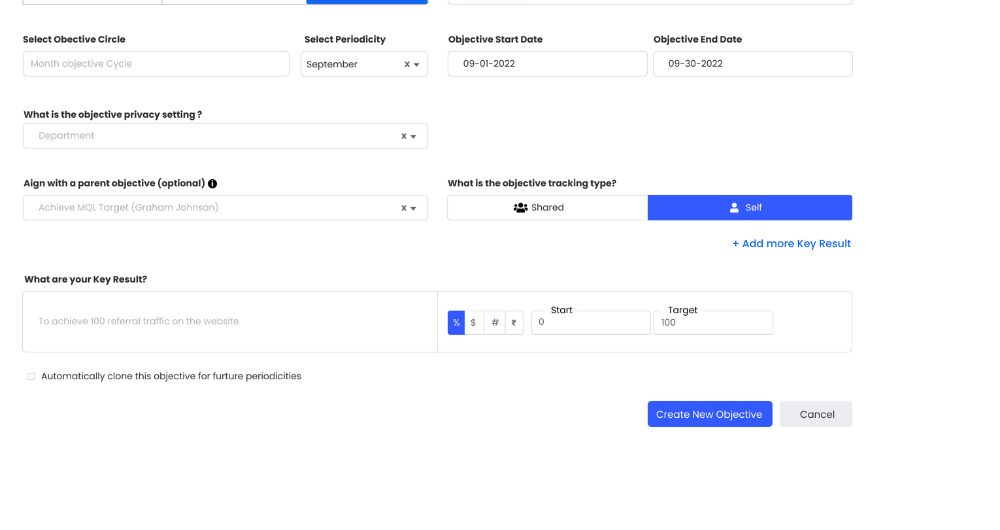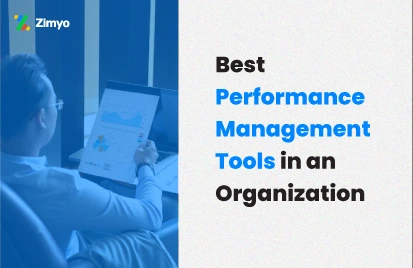While the pandemic proved to be a nightmare for many companies, it has certainly taught the world a new norm of work culture – remote working. Even with the increase in vaccination and lockdown being lifted, remote working seems likely to continue for a long time. According to a report by Forbes, remote working will continue to increase through 2023.
While many companies have adapted to the changes, managing the employee’s performance and aligning all the remote employee’s towards one single person seems to be one of the major challenges of remote working. You cannot monitor every aspect of remote employees and ensure clear communication between teams. So what can organizations do to improve remote employee’s productivity?
Objectives and Key Results is a goal-setting strategy that can help companies to set challenging goals for the remote team and align everyone towards one single objective. In this article, we will discuss how OKR can help manage remote employee productivity and how to set OKR for remote teams. However, before moving forward, let us first learn about the OKR meaning.
What are OKRs?
Objectives and Key Results is a goal-setting strategy that helps organizations to align their teams and focus on important tasks. The OKR framework allows the organization to set, track, and measure goals at team-level and company-wide levels while measuring the results.
The OKR is different from other goal-setting strategies like KPI and SMART goals as it allows teams to focus on important tasks while also measuring the results. The OKR framework is made of two components: “Objectives” and “Key Results.”
The Objectives part represents the ambitious goals that an organization or individual wants to achieve. Ideally, these goals are measured in a specific time frame and are qualitative in nature. For example, the Objective of the HR department can be to improve the retention rates in organizations.
The Key results are the measurable metrics that determine the success of the Objectives. Key results should be specific and quantitative in nature to measure the results of the initiatives. If we take the above example, to accomplish the Objective of improving the retention rates, the Key result could be to increase the incentive plans from 20% to 40%. Generally, you should set not more than 3 to 5 Key Results for every Objective to avoid confusion. If you are unfamiliar with the OKR, you can read OKR meaning to know more in-depth.
Benefits of OKR for Remote Teams

Lack of team alignment, communication of priorities, and lack of goal management and tracking are some of the major challenges while working with remote teams. OKR can help CEO to set challenging Objectives while constantly measuring the results and managing remote employee’s performance.
As remote working is becoming a new norm for many companies, setting up an OKR framework can help you overcome the challenges of remote working and ensure that everyone stays on the same line. Here are some benefits of using OKR for remote teams.
1. OKR Helps in Team Alignment and Tasks Prioritizing
Since every employee is working remotely, aligning teams towards common objectives and communicating the task priorities are some major issues. OKRs can be used to eliminate these issues by ensuring team alignment and task management.
In the OKR framework, the end goals of every employee align with the overall company’s goals. The OKRs for each employee are collaboratively set by both management and team members. Furthermore, all OKRs are visible to everyone, so remote team members can collaborate and work together. Thus, the OKR framework encourages both top-down and bottom-up team alignment.
While working remotely, employees can feel confused about task priority due to a lack of clarity and supervision. The OKRs are specifically designed to set priorities. So, an employee can easily set task priorities based on the set OKRs. As the goals are transparent and easily understood, everyone knows their task priorities while working remotely.
2. OKR Helps to Focus on End Goals and Overview the Progress
When OKRs are set for the remote teams, there are clear expectations set for every employee. The framework also describes the process for achieving the Objectives, and employees agree upon them. This helps eliminate the guesswork and allows the team to focus on important tasks. As a result, instead of measuring the working hours of remote employees, the focus is on the end goals.
Furthermore, the managers can constantly monitor the progress towards the goals by using the OKR check-ins from OKR software. This allows the team members to discuss what’s working and what’s not working more frequently than waiting for things to occur at the end. Thus, OKRs not only help in setting clear objectives but also enables the monitoring of goals to overcome the challenges of remote working.
3. Promotes a Culture of Accountability
The OKR framework is based on transparency and feedback on the goals. Team members and management collaboratively set the OKRs. Therefore, there is no ambiguity regarding the goals, and everyone takes ownership and responsibility for their goals. Furthermore, when results are achieved, it motivates the employees and makes them feel more valuable.
Moreover, when goals are set, everyone participates in the process. This makes them feel more connected to the goals and fosters collaboration between employees and management. Thus, OKR is an effective strategy for building a culture of accountability and ownership.
4. OKRs Help to Adopt Remote Working Culture
Remote working is a relatively new concept, and many companies are still struggling to adopt the changes. The traditional way of tracking the working hours and measuring productivity based on tasks is not relevant in remote working. Adopting OKR methodology is an effective way to manage remote employee’s productivity. Leaders can leverage the OKR software to manage remote team productivity by setting, tracking, and evaluating goals. The framework is perfect in every aspect of the performance management of remote employees. By setting quarterly Objectives and monitoring the success with Key Results, organizations can effectively manage remote worker’s productivity.
Steps to Set OKR for Remote Teams

Implementing any new process in the organization takes some time but once you get familiar with it, you can get tons of benefits. While setting up OKR for remote teams, it is recommended to opt for OKR software. Ideally, you should set OKR quarterly to see the results. Here are step-by-step process to set OKR for remote teams.
1. Introduce the Concept of OKR to Your Remote Team
The first step in setting up OKR for remote employees is to make sure that everybody understands the OKR methodology. As a management, you should clearly describe the benefits of OKR to the remote team and how it can be used to monitor the success. At the end of the day, it is the employees who will work with the OKR framework. Therefore, it is essential to get them involved in the implementation process and ask for their suggestions. Make sure that you clear every doubt or query of your team. You can consider taking help from OKR coaching to help your remote workers get started with OKR methodology.
2. Set the Objectives
Once you are done with onboarding your remote team with OKR methodology, the next step is to set the Objectives. It is important that you communicate the company’s goals and align the remote team’s goals with the company’s objectives. This will allow everyone to collaborate with each other and work towards the same goals. A good Objective should be ambitious, clearly defined, and time-bound. It is easy to get distracted from the goals when working remotely. Therefore, it is essential to create an OKR plan that clearly defines how every team can contribute to the goals.
3. Set Key Results
After setting objectives for your remote team, you need to create 3 to 5 Key results to measure the success of Objectives. By setting Key results, you can prioritize important tasks rather than tracking the working hours. It is important to set quantifiable Key Results to measure the Objective. For instance, if the Objective of the marketing team is to increase website traffic, the Key Result could be to increase the number of blog posts from 3 to 6 per month. By attaching the number to a Key Result, you can set the metrics for measuring the performance of Objective.
4. Set Up Tracking Process
Your job is not complete just by setting up the OKR process; continuously tracking the progress is crucial to know whether the team is keeping up with the process or not. Implementing OKR software is one of the best ways to make OKR tracking more smooth. By using the OKR software, you can regularly monitor the progress of goals and align everyone toward the bigger picture. The software also enables you to make the OKRs transparent for the entire organization to enable collaboration and engagement across all departments.
5. Execute the OKR
The final part of setting OKRs for remote teams is the execution of the set Objectives and Key Results. For effective execution, you need to break down your goals into smaller targets and assign them to the respective employees. After that, you need to decide on the time frame and deadlines for each task and how often they will be measured. Ideally, the best practice is to measure the OKR every quarter, but you can set your own time frame based on the kind of objectives you set for your team.
Common Mistakes that One Should Avoid

- Not Involving Team Members in OKR Process– When team members are not involved in the process, it only serves as guidelines passed down from top management to employees. It is essential that everyone takes part in the OKR setting process because, ultimately, they are the ones who are going to do the tasks. To involve your remote team in the OKR setting process, you can arrange for conference meetings and ask them to come up with their OKR ideas.
- Creating Too Many OKRs– The purpose of OKRs is to increase focus by prioritizing the important tasks. Creating too many OKRs can confuse employees and distract them from important tasks. Depending upon your team size and the difficulty of the task, you should not create more than 3 to 5 Objectives, as every Objective will also have corresponding Key Results. Instead of setting too many OKRs, you should just focus on key areas.
- Not Tracking OKRs- It is common to get distracted from your goals while working remotely from home. Therefore, it is important to follow up with everyone regarding the progress of Objectives. You can ensure effective OKR tracking by arranging a weekly meeting with the teams or implementing OKR software to track the goals.
- Unclear Objectives and Key Results- One of the worst mistakes that you can make while setting OKRs for remote teams is creating vague and unclear Objectives and Key Results. The Objective of every team should be challenging and align with organizational goals. Similarly, the Key Results should have a number attached to it so you can track the progress of Objective. The success metric of Objectives is based on Key Results. Therefore, you should ensure to brainstorm lots of ideas before finalizing Key Results for specific Objectives.
The Bottom Line
Gone are the days when employees had to travel for hours to reach the office to work. Remote working has made it possible for employees to work from any place and also enabled employers to find the best talents around the world. However, lack of communication and team alignment are some of the biggest hindrances of remote working.
Implementing OKR methodology is one of the most effective ways to manage the remote team’s productivity and achieve your business goals. However, starting with OKR is not an easy process. If the OKR strategy is not implemented clearly, it can make things even more complicated. Therefore, it is best to opt for OKR software to make the OKR implementation easy for remote workers.
By leveraging OKR tracking software, you can regularly monitor the progress of your goals and align every employee towards a single goal. Zimyo OKR software offers tons of advanced features like cascading, auto cloning, email reminders, reports, and insights that help you easily set OKR for your remote teams. Book a free demo with Zimyo OKR experts to start your OKR journey.




